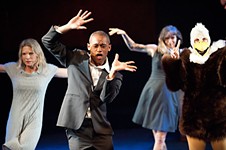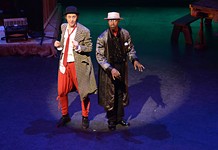Harmonic Convergence
Three stellar performers of Indian classical dance finally unite onstage
Reviewed by Robert Faires, Fri., March 5, 2010
When Anuradha Naimpally moved to Austin in 1989 and began to introduce herself as a performer of Indian classical dance, the response she'd get would invariably be: "Oh, do you know Gina Lalli?" It's the very same question that Vinitha Subramanian, another Indian classical dancer and founder of Natyalaya School of Dance, had heard when she moved to Central Texas eight years earlier. "Do you know Gina Lalli?" The query – a reference to the woman who introduced Indian classical dance to the city in the Seventies – proceeded from the not unnatural assumption that there couldn't be that many Indian classical dancers in the Texas capital, so they must all know one another, right?
Of course, even in the small circles of a city's cultural scene, artists working in the same traditions may labor side by side for years without making contact. (Case in point: Hannibal Lokumbe and Jeff Lofton, the two world-class jazz trumpeters recently featured on the cover of the Chronicle, who have both been Central Texas residents since 2007 but had not met before being brought together for the photo shoot for that issue.) So perhaps it won't surprise you to learn that at the time of their respective arrivals here, neither Naimpally nor Subramanian were acquainted with Lalli or that it turned out to be several years before either met her – in Subramanian's case, more than two decades. In fact, it took almost that long for Subramanian and Naimpally themselves to connect.
Now, however, those two women can say not only that they know Gina Lalli but that they dance with her. This week, the three share a stage in Parampara: Traditional Dance of India, a program that showcases the particular classical dance form that all three have studied, Bharata Natyam, as well as the various individual styles each absorbed from the gurus with whom they studied. "The name of the show," says Naimpally, who conceived the program and is producing it through her company, Austin Dance India, "means 'unbroken tradition.' The flow of a tradition is the parampara, passed down from guru to disciple. Three of these traditions are converging in this performance, which is unusual."
The qualities that each woman has drawn from those different traditions are as distinctive as their personal histories. For Lalli, a New Yorker who felt a deep kinship with the culture of India from a young age and made three journeys to the subcontinent to train there, the expressiveness of the dance was grounded in precision. "My school had very closed steps, very rigorous, and some of them almost impossible for the body to do," she says. "You're doing like mathematical equations: [makes gestures] exactly here, then exactly here." For Subramanian, who began dancing at age 4 in her native India, the dance grows out of a mental connection with the music. "What I get from my master and the training," she says, "is the instantaneous choreography and the ability to visualize the movement in your mind once the music suggests something to you. That's the main thing I got out of it, because I watched him do that." And for Naimpally, who started her studies in Indian classical dance when her family lived in northwestern Ontario, the key is investing every gesture with as much meaning as possible. Her teachers, she says, "would take one word of a piece and try to go into depth with that one word for a week of something until I could get all the nuances of that word, the poetic undertones of that word that you have to bring out in the dancing. What they gave me was the ability to visualize not only the music but the inner meanings of the poetry. What is the poet trying to say with that one word? What are the nuances of that that then you can express through the dance?"
Naimpally felt the program could be a vehicle for showing that, "although dance is most definitely rooted in the physical body, it also transcends it. The three of us come from varied backgrounds – Madurai, India; New York, USA; Thunder Bay, Canada – and also dance traditions. We are also at different stages of our lives and careers. The dance expresses itself very differently through each of us. I feel there is a very different beauty in witnessing a mature person articulate the movements that comes from within. Bharata Natyam is a very forgiving technique that allows for this. An older dancer can focus more on the abhinaya, or expressive aspect of the dance. I wanted to highlight the beauty of variety within Bharata Natyam through style as well as age and background."
In coming together, these dancers of varying lineages, all of whom have experience teaching, have been able to become students again. "When we trained in our tradition and in our masters' lineage, there was a little tunnel vision. You prepared it a certain way," says Subramanian. "But when you interact with other teachers and with people who have trained in their own lineages, then you gain a totally different perspective in looking at things. And I think that enriches you as a teacher as well as a dancer and choreographer."
"I have been learning a lot through this experience," insists Naimpally. "Gina [Lalli] has been teaching me some of her traditional repertoire, in her style, which doesn't fit well with my body right now, but I'm practicing."
To which Lalli responds: "She's very bright and a very good dancer. To have a good student is what every teacher longs for, a really great student, and she's it."
Even the eldest in this trio, the local legend whose pioneering work with Indian classical dance locally earned her induction in the Austin Arts Hall of Fame, has picked up a lesson or two here. From Naimpally, who is the main person suggesting the steps in the group dances, Lalli has learned some new variations. Those mathematical equationlike steps she mentioned earlier, "when you link them together, in my school, they're not always pretty," she says. "They don't always fit together. Some are here, and some are way over there, and some are back, and it's almost impossible for the body to do it. So you do the best you can. But Anuradha has different choreography which has much smoother transitions, and it's given me inspiration of another way it could be done."
For this dancer, who had been unable to practice her art for some time due to health issues, this is "a renewal. A resurrection!"
And it won't end here. Naimpally is already working on a follow-up program for November. The flow of the Bharata Natyam tradition will continue, even here, half a world away from its source and deep in the heart of Texas.
Parampara: Traditional Dance of India will be performed Sunday, March 7, 3pm, in the Boyd Vance Theatre of the Carver Cultural Center, 1165 Angelina. For more information, visit www.austindanceindia.com.














